| Botanical Name |
|
| Family |
Euphorbiaceae - The euphorbia family. |
| Pronunciation |
yoo-FOR-bee-uh try-an-gew-LAIR-iss |
| Common Name(s) |
English: River euphorbia; Chandelier Tree
Afrikaans: Riviernaboom; Noorsdoring
|
| Plant Group |
- Tree A woody, self-supporting perennial plant usually with a single main stem and generally growing more than 6 meters tall.
|
| Plant Size |
- Medium
| Tree | 10m to 16m |
| Shrub | 1m to 2m |
| Perennial/ground cover | 40cm to 60cm |
| Bulb | 40cm to 60cm |
| Succulent | 40cm to 60cm |
|
| Position |
- Canopy Shade Canopy shade is found below closely grown trees where some light filters through. Ideal for the protection of herbaceous plants.
- Light or Dappled Shade Found below trees with sparse, open foliage. Ideal for the protection of herbaceous plants.
- Sun The area is in full sun for all or most of the day, all year round.
|
| General Information |
- Deciduous Plants which completely lose their foliage for part of the year.
- Drought Tolerance: High The plant is well adapted to arid conditions; it can survive long periods of drought and high temperatures without extra water.
- Frost: Tender A plant that will not survive any frost or low winter temperatures.
- Water Wise Plant species originating from low rainfall regions that require less water to survive and thrive than other plant species.
- Wind Tolerant Plants able to withstand the effect of strong winds.
|
| Specific Information |
Euphorbia triangularis is a succulent, deciduous, spiny tree, usually with a single trunk and several branches clustered in whorls. This is the most common tree Euphorbia in the Eastern Cape Province. Euphorbia triangularis can be 3, 4 or 5-angled. The 3-angled form occurs more often in the Eastern Cape and the 5-angled form in KwaZulu-Natal.
As with many other Euphorbias the latex sap is toxic and direct contact with it should be avoided. Fortunately they seldom need pruning and their thorns present a formidable barrier to the unwary.
|
| Ad Break |
|
| Flowers |
| Description |
|
| Season |
- Winter Plants will seldom bloom for the entire season as given in the list, but should flower during a period within these parameters.
|
| Colour |
|
| Growth Rate |
- Slow to Moderate Specifying growth rate can be very misleading as there is considerable variation of growth rate depending on type and species of plant, available water, supplementary feeding, mulching and general care, as well as the plants suitability and adaptability to the garden environment.
|
| Plant Uses |
- Accent or Focal Point A plant used to attract the attention because of its colour or form.
- Attracts bees, butterflies or other insects This plant attracts insects which can be food for birds or other creatures in your garden.
- Attracts Birds This plant will attract birds.
- Boundary A plant useful for planting around the edges of the property to form a green or colourful backdrop, an impenetrable hedge, to hide walls or create privacy.
- Filler Either a fast growing tree or shrub used temporarily to fill in an area while the permanent plants grow to a desired size, or a plant used to fill gaps in borders or beds.
- Foliage Plant Plants grown because their foliage is colorful or unique. Many of these plants have insignificant flowers.
- Hedge Suitable trees or shrubs planted relatively close together so that the branches intertwine to create a barrier. This can be formal – the plants are regularly trimmed to produce a neat shape, or informal – the plants are left to themselves to create a natural hedgerow.
- Rock Garden An area constructed of larger rocks, arranged naturally, to emphasise the use of stones as a main element. Generally plants used do not need a lot of care.
- Suitable for coastal gardens Plants adapted to dry, sandy soil, forceful wind, limited rainfall and intense sunlight.
- Suitable for seaside gardens Plants that will survive the hostile environment of harsh salty winds, dry sandy soil, irregular rainfall and heat found in seaside gardens.
- Wild Garden An indigenous garden planted for the benefit of wildlife and birds. Provides food, water, a variety of mini-biomes and no poisonous chemicals are used.
|
| Distribution and Habitat |
in the Eastern Cape and KwaZulu-Natal, in river bush thicket, on dry, rocky and clayey slopes of river valleys, in open dry woodland and on coastal dunes.
|
| Planting Suggestions |
Plant in well drained soil in a sunny position. Add compost to the soil and mulch well to retain moisture. If given some extra water during dry spells, this Euphorbia will bush out and grow faster. If you want a more natural effect, keep the tree very dry and it will grow up rather than out, but rather slowly.
The plants can be propagated from seed or cuttings.
The old method of digging a deep hole and filling it with soil and compost has resulted in many trees failing to thrive, dying, rotting at the base or worse still, falling over in later years due to poor root development. Refer to the following sites for the best method of planting trees:
Treehelp.com: Planting a tree
International Society of Arboriculture: New Tree Planting
Tree People: Plant the right way
For those of you who have a clay problem try:
Rod's Garden: Planting in clay soil
|
| Lorraine's Garden Notes |
The self-sown seedling in the last picture germinated on top of the stem of a Portulacaria afra or Spekboom. Presumably it has received few nutrients as this little plant is now seven years old and seems permanently stunted.
|
| Medicinal Uses |
It is a tradition of the Xhosa after the birth and for the protection of twins, to plant a tree outside the hut .
|
| Ad Break |
|


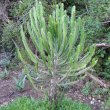
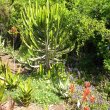
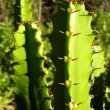
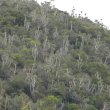
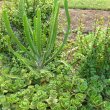
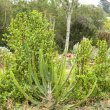


Comments
Eastern Cape Thicket
Great that you grow and promote local indigenous plant species. Perhaps you would be interested in attending the Thicket Forum, to be held in Grahamstown on 2 and 3 November 2011. More info www.thicketforum.co.za or email Mike on m.powell@ru.ac.za
Discuss this plant
Share knowledge, ask a question or give an experience.